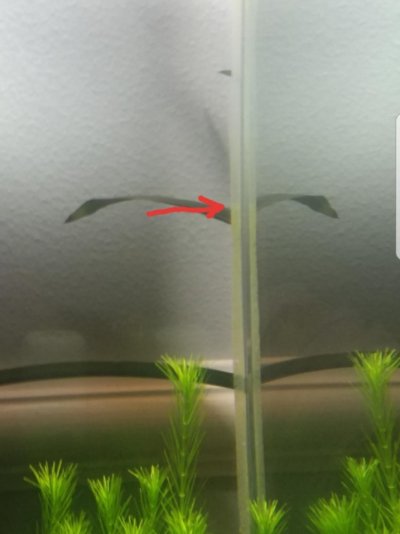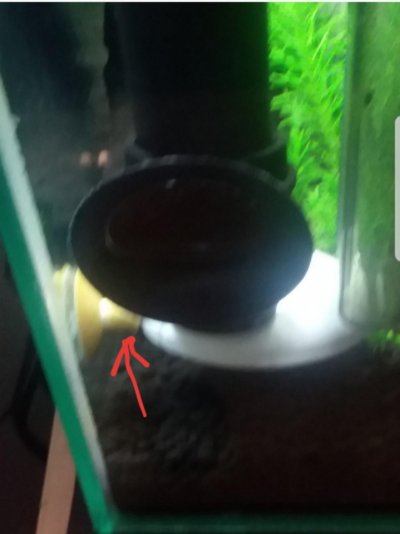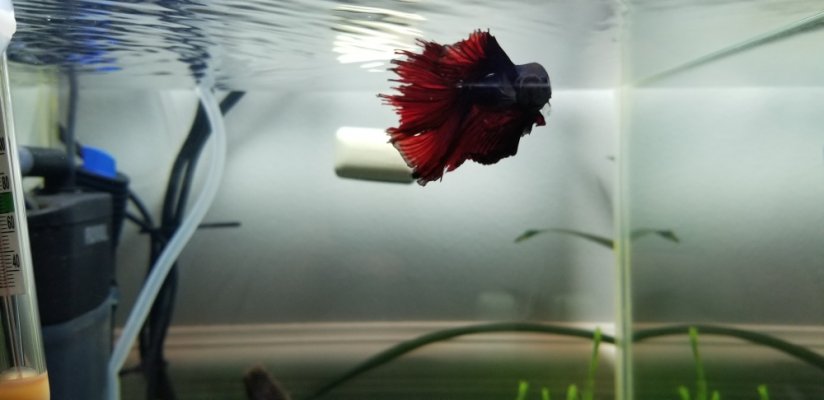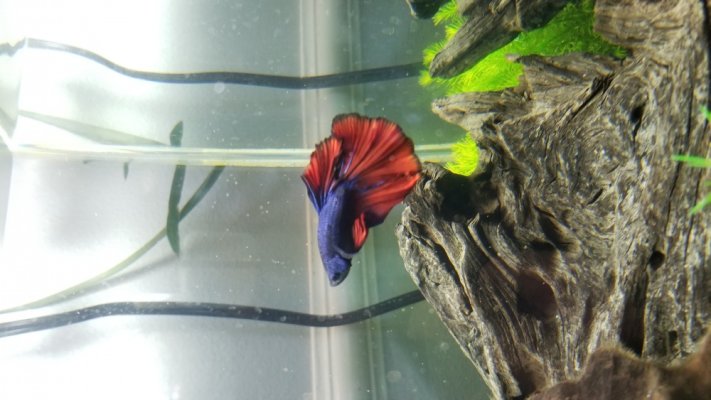fishfanatic
Aquarium Advice Addict
- Joined
- Apr 6, 2011
- Messages
- 2,038
long version:
Here we go I'll start from the top. I have kept several aquariums in the past but have taken a five or so year break from the hobby. My wife decided last month for my birthday to surprise me by encouraging me to set up one of my previous tanks. I set the tank up and began the process of fishless cycling on September 28th. I was using the 10% strength ammonia from ace hardware to dose the tank to approximately 2-4 ppm, I also began lightly planting the tank, this went on for 2 weeks or so until my wife (bless her heart) Oct 18th got an idea that she would surprise me with a Betta. At this point the cycle was not finished I was starting to see some decrease in ammonia but no real detectable nitrItes. So here is when my judgment starts to fail me, I thought that my tank couldn't possibly be any worse then the cup the Betta was sitting in. I did several large water changes to get the ammonia levels down and went through the process of adding the little guy to the tank. Knowing that I was now doing a Fish in cycle I started doing daily 50% water changes trying to battle the ammonia levels. Fast forward to a few days ago, I got sick and was unable to keep up on the daily water changes for several days when I finally came around Sunday the ammonia was sitting around .5 ppm
I started doing daily 50% water changes trying to battle the ammonia levels. Fast forward to a few days ago, I got sick and was unable to keep up on the daily water changes for several days when I finally came around Sunday the ammonia was sitting around .5 ppm  and I started to notice signs of fin rot which has been progressing very quickly. I immediately did a 50% water change waited a few hours and did another 50% water change.
and I started to notice signs of fin rot which has been progressing very quickly. I immediately did a 50% water change waited a few hours and did another 50% water change.
These levels of ammonia would obviously stress the fish and is probably the cause the of the fin rot however I have another strange thing with the tank that I would like advice with. Early into cycling the tank I started to notice some yellow spots appearing on the silicone seals of the aquarium and can be scrapped off with my fingernail. The white suction cup on my CO2 defuse also turned a yellowish color not long after putting it into the tank (not sure if its related). They only appeared on the silicone and suction cup nowhere else, could this be a type of bacteria or fungus that could be contributing to the fin rot? Does anyone know what the yellow spots actually are? Is it some kind of reaction from the ammonia I was adding when cycling the tank? Any thoughts on this would be great!
summary:
1) My new Betta is suffering from fin rot that has been progressing very rapidly.
The most obvious cause is elevated ammonia levels, however they were only elevated for 2-3 days before I noticed. Could the effects of elevated ammonia happen that quickly?
2) There are strange yellow spots on the silicone of the aquarium and the suction cup of the CO2 diffuser. The yellow spots on the silicone can be scraped off with my fingernail. Could these be a problem/ be adding to the fin rot?
about the tank:
-7.9 gallon (Fluval Flora)
-temp 78 degrees F
-CO2 injected (turned off for now to minimize stress on the fish)
-no plant ferts as of yet have been added to the aquarium
-was fishless cycling for about 10 days until it became fish in cycling
-most of the time the fish has been in the tank the ammonia has been just a slight shade about 0~.1ppm, nitrItes 0ppm, nitrAtes ~ 5ppm. The last 2-3 days the ammonia elevated to .25~.5ppm, nitrItes 0ppm, and nitrAtes ~5ppm.
-tap water conditioner API stress coat (tap water has 0ppm ammonia)
-fish diet Aqueon Betta Food (every day), and live brine shrimp (once a week)
steps taken so far:
-yesterday I did two 50% water changes several hours apart.
-lowered the aquarium temp to 76 (I read this can slow down the bacteria growth a little)
possible solutions in my mind:
1) move plants to another container and add 1 teaspoon/gal aquarium salt while continuing 50% daily water changes
2) move the fish to a makeshift QT (plastic tub with heater and air stone) and dose QT with aquarium salt and or Jungle Fungus Clear (or other medication) while I try to figure out the yellow stop stuff.
3) move plants to another container and dose the entire aquarium with medication and see if that clears up the yellow spots and the fin rot.
4) insert your suggestions.
I will attach a few photos
(1) the yellow stuff on the silicone here half is scraped off
(2) the yellowing of the originally white suction cup
(3) the Betta as he looks now
(4) the Betta as he looked before (also the yellow stuff visible on the silicone)
Thank you all so much for all your help and advice!
Here we go I'll start from the top. I have kept several aquariums in the past but have taken a five or so year break from the hobby. My wife decided last month for my birthday to surprise me by encouraging me to set up one of my previous tanks. I set the tank up and began the process of fishless cycling on September 28th. I was using the 10% strength ammonia from ace hardware to dose the tank to approximately 2-4 ppm, I also began lightly planting the tank, this went on for 2 weeks or so until my wife (bless her heart) Oct 18th got an idea that she would surprise me with a Betta. At this point the cycle was not finished I was starting to see some decrease in ammonia but no real detectable nitrItes. So here is when my judgment starts to fail me, I thought that my tank couldn't possibly be any worse then the cup the Betta was sitting in. I did several large water changes to get the ammonia levels down and went through the process of adding the little guy to the tank. Knowing that I was now doing a Fish in cycle
 I started doing daily 50% water changes trying to battle the ammonia levels. Fast forward to a few days ago, I got sick and was unable to keep up on the daily water changes for several days when I finally came around Sunday the ammonia was sitting around .5 ppm
I started doing daily 50% water changes trying to battle the ammonia levels. Fast forward to a few days ago, I got sick and was unable to keep up on the daily water changes for several days when I finally came around Sunday the ammonia was sitting around .5 ppm  and I started to notice signs of fin rot which has been progressing very quickly. I immediately did a 50% water change waited a few hours and did another 50% water change.
and I started to notice signs of fin rot which has been progressing very quickly. I immediately did a 50% water change waited a few hours and did another 50% water change. These levels of ammonia would obviously stress the fish and is probably the cause the of the fin rot however I have another strange thing with the tank that I would like advice with. Early into cycling the tank I started to notice some yellow spots appearing on the silicone seals of the aquarium and can be scrapped off with my fingernail. The white suction cup on my CO2 defuse also turned a yellowish color not long after putting it into the tank (not sure if its related). They only appeared on the silicone and suction cup nowhere else, could this be a type of bacteria or fungus that could be contributing to the fin rot? Does anyone know what the yellow spots actually are? Is it some kind of reaction from the ammonia I was adding when cycling the tank? Any thoughts on this would be great!
summary:
1) My new Betta is suffering from fin rot that has been progressing very rapidly.
The most obvious cause is elevated ammonia levels, however they were only elevated for 2-3 days before I noticed. Could the effects of elevated ammonia happen that quickly?
2) There are strange yellow spots on the silicone of the aquarium and the suction cup of the CO2 diffuser. The yellow spots on the silicone can be scraped off with my fingernail. Could these be a problem/ be adding to the fin rot?
about the tank:
-7.9 gallon (Fluval Flora)
-temp 78 degrees F
-CO2 injected (turned off for now to minimize stress on the fish)
-no plant ferts as of yet have been added to the aquarium
-was fishless cycling for about 10 days until it became fish in cycling
-most of the time the fish has been in the tank the ammonia has been just a slight shade about 0~.1ppm, nitrItes 0ppm, nitrAtes ~ 5ppm. The last 2-3 days the ammonia elevated to .25~.5ppm, nitrItes 0ppm, and nitrAtes ~5ppm.
-tap water conditioner API stress coat (tap water has 0ppm ammonia)
-fish diet Aqueon Betta Food (every day), and live brine shrimp (once a week)
steps taken so far:
-yesterday I did two 50% water changes several hours apart.
-lowered the aquarium temp to 76 (I read this can slow down the bacteria growth a little)
possible solutions in my mind:
1) move plants to another container and add 1 teaspoon/gal aquarium salt while continuing 50% daily water changes
2) move the fish to a makeshift QT (plastic tub with heater and air stone) and dose QT with aquarium salt and or Jungle Fungus Clear (or other medication) while I try to figure out the yellow stop stuff.
3) move plants to another container and dose the entire aquarium with medication and see if that clears up the yellow spots and the fin rot.
4) insert your suggestions.
I will attach a few photos
(1) the yellow stuff on the silicone here half is scraped off
(2) the yellowing of the originally white suction cup
(3) the Betta as he looks now
(4) the Betta as he looked before (also the yellow stuff visible on the silicone)
Thank you all so much for all your help and advice!




